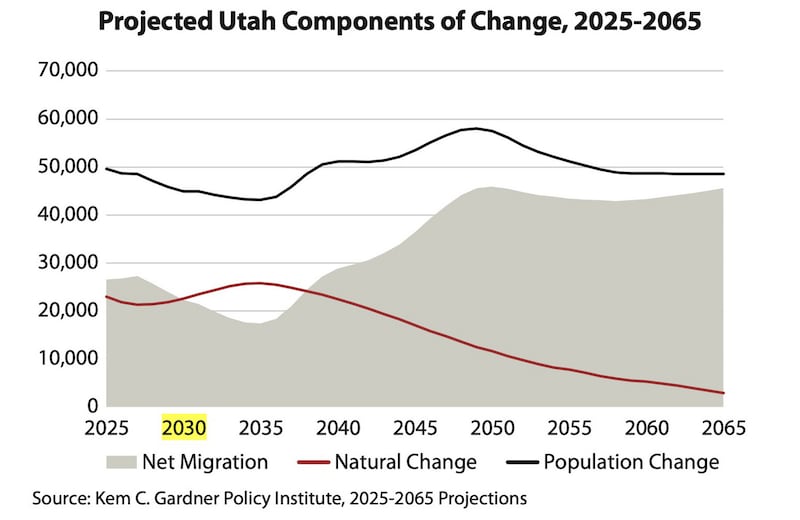Utah remains on pace to add 2 million more people over the next 40 years, but the state’s rate of growth may continue to slide over the next few decades, according to a new projection of statewide population trends.
The Beehive State’s population, which recently surpassed 3.5 million, is projected to surpass 5.5 million by 2065, per the updated long-term planning projection released by the University of Utah’s Kem C. Gardner Policy Institute on Tuesday. It’s the institute’s first update to long-term projections since 2022, when experts estimated Utah’s population could come close to 5.5 million by 2060.
Researchers project that Utah’s population growth may quintuple the U.S. average over the next 40 years, as its employment growth triples the national average. It signals that Utah’s economy should remain strong enough to add a population that researchers point out is the “approximate size of Idaho today.”
Utah County, which continues to lead the state in growth every year, is anticipated to double its population over the next 40 years, leading the way with an estimated addition of more than 750,000 people. If the projections come to fruition, it will have over 1.5 million residents, just behind Salt Lake County and its estimated 1.6 million residents.
The estimates are based on a mix of economic and demographic trends from federal, state and private sources. However, the paper finds that percentage growth — a category that Utah led the nation in after the 2020 Census — may decline over the next four decades.
Some of that is tied to declining fertility rates that are projected to slide further, while growth in net migration — a measure of people moving in over people moving out — may plateau by the 2050s.
In their 2022 report, Gardner Policy Institute researchers estimated that Utah could reach 5 million residents for the first time in 2051 before the state’s population reaches 5.45 million by 2060. Tuesday’s report extends projections out to 2065, but they now estimate Utah may reach a population of 5 million in 2054, and over 5.3 million by 2060, before reaching 5.55 million by 2065.

Utah may look vastly different by 2065, too. With no signs of fertility rates changing, the institute projects that Utah’s median age could rise from 32.8 to 45.3 by 2065, as the state’s 65 or over population could increase from about 13% of the state’s population to a quarter.
Meanwhile, there’s an anticipation that tech, finance and health care industries will continue to grow, along with state government jobs and waste management and remediation services. Transportation, federal civilian, farm, military and utilities jobs, on the other hand, are projected to drop the most over the next four decades.
“The Utah economy plays a vital role, with the health care, professional services, finance and construction industries leading growth through 2065,” the report states.
The institute says it also plans to publish additional numbers next year that highlight potentially high-end and low-end growth scenarios based on uncertainties that may exist by 2065.

